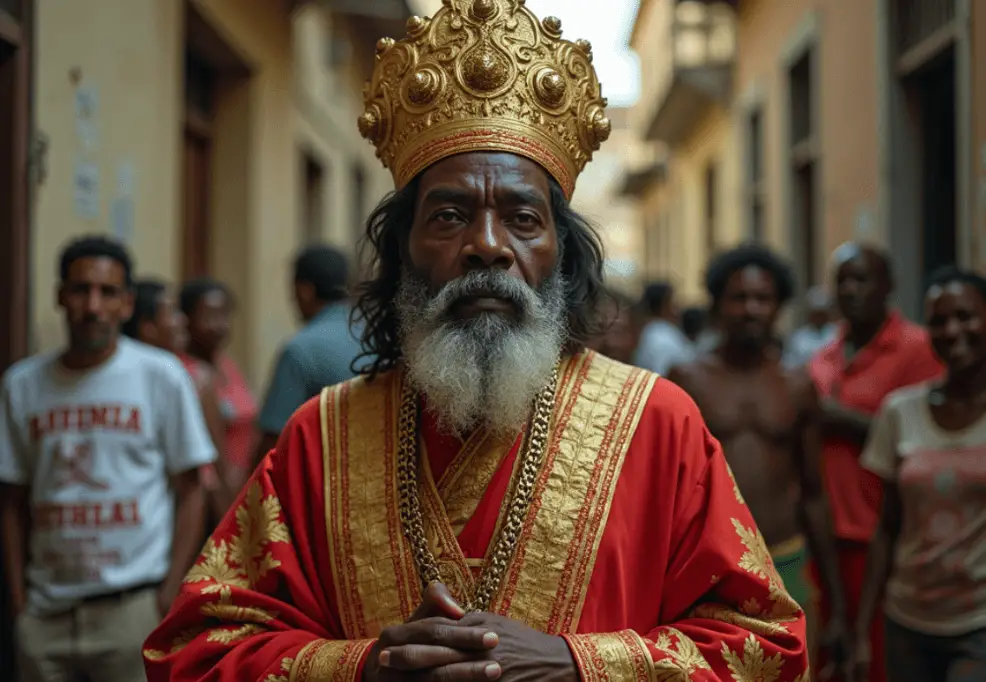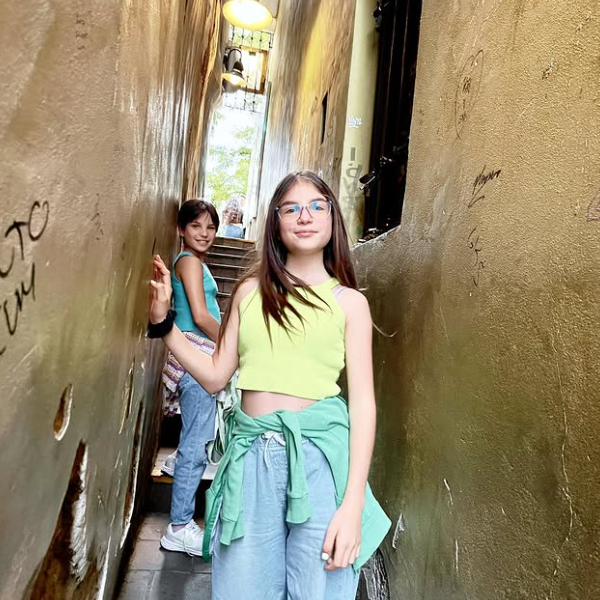St. Lazarus Abba Kwi represents a remarkable fusion of religious traditions in Cuban spiritual culture, blending Catholic and Yoruba beliefs into a powerful symbol of healing and protection.
Known as Babalu Aye in Santería, this revered figure embodies the unique syncretic nature of Afro-Cuban religious practices that emerged during the era of the transatlantic slave trade.
His significance extends far beyond religious boundaries, touching the lives of countless Cubans who seek his divine intervention for healing and protection.
The annual December 17th pilgrimage to the Church of El Rincón near Havana draws thousands of devoted followers, many of whom walk barefoot or crawl on their knees as acts of deep devotion.
The traditional imagery of St. Lazarus as an elderly man with crutches, accompanied by two loyal dogs, carries profound meaning in both Catholic and Santería traditions, symbolizing humility, suffering, and the power to heal.
Through ritual offerings of food, candles, flowers, and cigars, devotees maintain a spiritual connection with this powerful figure who has become deeply woven into the fabric of Cuban cultural identity.
Historical Background of St. Lazarus Abba Kwi
Origins and Evolution
The story of St. Lazarus Abba Kwi begins with the arrival of Yoruba traditions during the transatlantic slave trade. The name itself has deep African roots, with “Abba” meaning “father” and “Kwi” referring to a respected figure.
In Yoruba belief systems, he was known as Babalu Aye, a powerful deity associated with healing and protection from diseases.
Catholic Integration
During the period of Spanish colonization, the merging of religious traditions took shape. Catholic missionaries introduced the biblical figure of St. Lazarus, known from two distinct gospel stories – the man raised from the dead and the poor beggar covered in sores.
This Catholic influence blended naturally with the Yoruba healing deity, as both figures represented suffering and divine intervention.
Cuban Cultural Development
The evolution of St. Lazarus Abba Kwi in Cuban society created a unique form of worship called Santería, where African deities (Orishas) were associated with Catholic saints.
This syncretic practice allowed enslaved people to maintain their traditional beliefs while appearing to practice Catholicism. The fusion became so complete that by the late 19th century, St. Lazarus Abba Kwi had become a central figure in Cuban spiritual life.
Modern Expression
Today, this religious fusion is most visible in the annual pilgrimage to El Rincón church near Havana on December 17th. Thousands of devotees participate in this event, many crawling on their knees or walking barefoot as acts of devotion.
The traditional depiction shows him as an elderly man with crutches and two dogs, symbolizing both his Catholic and Yoruba heritage.
The enduring presence of St. Lazarus Abba Kwi in Cuban culture demonstrates how religious traditions can adapt and thrive through cultural blending.
His veneration continues to evolve, now incorporating modern elements while maintaining its historical roots in both African and European traditions.
Religious Significance
Spiritual Identity
In Cuban Santería, St. Lazarus Abba Kwi holds a unique position as one of the most powerful Orishas, known as Babalu Aye. This divine figure represents a perfect fusion of African and Catholic beliefs, serving as a master healer and protector against diseases.
Divine Powers
Babalu Aye is particularly associated with healing serious ailments, especially those affecting the skin and bones. As the lord of disease and healing, he commands special respect among devotees who seek his intervention for physical and spiritual healing.
His power is so revered that many Cubans follow the saying, “I don’t believe in it, but I respect it”.
Catholic Symbolism
The Catholic interpretation connects him to two biblical figures: Lazarus of Bethany, who was resurrected by Jesus, and Lazarus the Beggar, who appears in Jesus’s parable covered in sores.
This dual identity strengthens his association with suffering and divine intervention. The traditional imagery shows him as an elderly man with crutches, accompanied by dogs – symbols representing loyalty and compassion.
Ritual Practices
Devotees honor St. Lazarus Abba Kwi through specific rituals and offerings. The most significant celebration occurs during the annual pilgrimage to El Rincón on December 17th, where thousands demonstrate their faith through acts of devotion.
Many crawl on their knees or walk barefoot, wearing rough burlap clothing as a symbol of humility and sacrifice.
Cultural Impact
Beyond religious significance, St. Lazarus Abba Kwi represents resilience and hope in Cuban culture. His veneration transcends religious boundaries, making him a unifying figure in Cuban society.
The syncretic nature of his worship exemplifies how African spiritual elements seamlessly merged with Catholic symbolism to create a unique cultural identity.
Cultural Manifestations
Annual Celebrations
The most significant celebration of St. Lazarus Abba Kwi occurs on December 17th at the shrine of El Rincón near Havana. Thousands of Cuban devotees gather for this powerful display of faith and cultural tradition.
Pilgrimage Practices
Devotees demonstrate their faith through remarkable acts of devotion. Many walk barefoot or crawl on their knees to the shrine, while others carry heavy crosses or wear rough burlap clothing. These physical sacrifices represent deep spiritual commitment and requests for healing or protection.
Community Rituals
Santería ceremonies include vibrant elements that showcase the blend of African and Catholic traditions:
Drumming ceremonies with energetic dancing
Herbal bath rituals for spiritual cleansing
Offerings of food, candles, and flowers
Animal sacrifices following traditional Yoruba customs
Sacred Elements
Home altars play a central role in daily worship. Devotees create sacred spaces featuring:
- Images of St. Lazarus with his traditional crutches
- Statues of loyal dogs
- Purple and white candles
- Fresh flowers and tobacco offerings
Modern Adaptations
The tradition continues to evolve while maintaining its core spiritual significance. Contemporary practices now include virtual pilgrimages and online prayer groups, especially for those unable to attend physical ceremonies.
This adaptation ensures the preservation of these sacred traditions while making them accessible to a broader community.
The celebration of St. Lazarus Abba Kwi represents more than religious devotion – it embodies the resilient spirit of Cuban culture and its ability to preserve and adapt sacred traditions through generations.
St. Lazarus Abba Kwi Symbolic Elements
Traditional Imagery
St. Lazarus Abba Kwi is traditionally depicted as an elderly man with distinctive features. He appears wearing tattered garments and using crutches, symbolizing humility and suffering.
This powerful imagery represents both physical affliction and spiritual healing, connecting deeply with devotees seeking divine intervention.
Sacred Objects
The veneration involves specific sacred items that carry deep spiritual meaning:
- Crutches symbolize support and healing
- Burlap clothing represents humility and penance
- Purple and white candles for spiritual illumination
- Fresh flowers as offerings of devotion
Color Symbolism
The colors associated with St. Lazarus carry specific meanings in Cuban Santería:
Purple represents spiritual power and transformation
White symbolizes purity and divine connection
Brown (from burlap) signifies humility and earthly connection
Animal Associations
The most significant animal symbol is the presence of two dogs in St. Lazarus’s imagery. These faithful companions represent:
- Loyalty and unconditional devotion
- Protection for the suffering
- Healing through companionship
The dogs are often depicted tending to their master’s wounds, emphasizing themes of care and compassion. This powerful symbolism resonates particularly with those seeking healing and protection.
Sacred Space
Devotees create personal altars featuring these symbolic elements, forming sacred spaces for prayer and meditation. These altars typically include statues, candles, and offerings, creating a focal point for spiritual connection and healing practices.
The arrangement of these elements follows traditional Santería guidelines, maintaining the sacred balance between Catholic and Yoruba traditions.
Healing Traditions
Types of Healing
St. Lazarus Abba Kwi specializes in healing specific ailments, particularly those affecting the skin, bones, and infectious diseases. His healing power extends beyond physical ailments to include emotional and spiritual healing, providing comfort to those suffering from various afflictions.
Ritual Practices
The healing rituals involve multiple elements:
- Herbal cleansing baths for spiritual purification
- Drumming ceremonies with energetic dancing
- Prayer circles for collective healing
- Meditation sessions guided by spiritual leaders
Sacred Offerings
Devotees make specific offerings to invoke healing powers:
Purple and white candles for spiritual illumination
Fresh flowers and tobacco as sacred gifts
Food offerings including rum and coconut
Personal items representing sacrifice
Promesas System
The promesa tradition forms a crucial part of the healing process. Devotees make personal promises in exchange for healing, such as:
- Walking barefoot during pilgrimages
- Making charitable donations
- Performing acts of community service
- Wearing rough burlap clothing
Modern Applications
Contemporary healing practices have evolved to include:
Virtual healing circles for remote devotees
Online prayer groups connecting global communities
Social media platforms sharing testimonials of healing
Community support networks providing emotional assistance
The healing traditions of St. Lazarus Abba Kwi continue to adapt while maintaining their spiritual essence. Many devotees carry medallions or wear images as protective talismans, blending ancient practices with modern needs.
The combination of traditional rituals and contemporary applications creates a dynamic healing system that serves both individual and community needs.
St. Lazarus Abba Kwi Contemporary Practice
Modern Devotion
St. Lazarus Abba Kwi worship has evolved to meet contemporary needs while maintaining its spiritual essence. Modern devotees now embrace both traditional and digital forms of worship, creating virtual communities that extend beyond geographical boundaries.
Urban Adaptations
In urban settings, practitioners have adapted traditional rituals to fit modern lifestyles:
- Virtual healing circles connect believers worldwide
- Online prayer groups facilitate community support
- Social media platforms share testimonials and teachings
Global Reach
The influence of St. Lazarus Abba Kwi has spread significantly through the Cuban diaspora, particularly in cities like Miami, New York, and across Mexico. Communities maintain their spiritual connection through:
- Annual celebrations in major cities
- Community gatherings in cultural centers
- Adaptation of traditional rituals to urban spaces
Diaspora Impact
The Cuban diaspora plays a crucial role in preserving and evolving these traditions. In places with large Cuban communities:
Local shrines and temples maintain traditional practices
Cultural festivals celebrate both spiritual and cultural aspects
Young generations learn traditions through modern educational initiatives
Digital Integration
Modern technology has revolutionized how people connect with St. Lazarus Abba Kwi:
- Mobile apps for daily prayers and meditation
- Live-streamed ceremonies from significant spiritual sites
- Digital altars for those unable to maintain physical spaces
Despite these modern adaptations, the core spiritual essence of St. Lazarus Abba Kwi remains intact, demonstrating the resilience and adaptability of this profound cultural tradition.
Read More: A Comprehensive Guide to www.gravityinternetnet
St. Lazarus Abba Kwi Cultural Impact
Societal Influence
St. Lazarus Abba Kwi has profoundly shaped Cuban society, transcending religious boundaries to become a cultural icon. His influence touches daily life through various expressions of art, music, and literature, representing the resilience and faith of the Cuban people.
Artistic Expression
Visual representations of St. Lazarus appear throughout Cuban art:
- Traditional religious paintings in churches
- Modern street art in urban areas
- Home altars featuring personal artistic interpretations
- Contemporary gallery exhibitions exploring syncretic themes
Cultural Integration
The figure of St. Lazarus Abba Kwi has become deeply woven into Cuban identity, influencing:
Community festivals and celebrations
Social gatherings and cultural events
Family traditions passed through generations
Public spaces and architectural designs
Modern Impact
In contemporary Cuban society, St. Lazarus continues to inspire:
- Digital art and social media content
- Community support networks
- Cultural preservation initiatives
- Educational programs about Cuban heritage
Folklore and Tradition
The legacy of St. Lazarus Abba Kwi lives on through:
Oral histories shared within families
Traditional healing practices
Community storytelling
Cultural performances and ceremonies
The cultural impact of St. Lazarus Abba Kwi demonstrates how religious figures can transcend their spiritual origins to become powerful symbols of national identity and cultural resilience.
His influence continues to evolve, adapting to modern expressions while maintaining deep connections to Cuban traditions.
Conclusion
The enduring legacy of St. Lazarus Abba Kwi showcases the remarkable fusion of African and Catholic traditions in Cuban culture.
Through centuries of evolution, this powerful spiritual figure has maintained his significance while adapting to changing times.
From the traditional annual pilgrimage at El Rincón to modern digital worship practices, his influence continues to grow and transform.
The blend of healing traditions, ritual practices, and cultural celebrations demonstrates how St. Lazarus Abba Kwi serves as more than just a religious figure – he represents the resilient spirit of the Cuban people.
His worship has spread globally through the Cuban diaspora, creating new communities while preserving ancient traditions.
As Cuban society continues to evolve, the veneration of St. Lazarus Abba Kwi adapts and thrives, proving that spiritual traditions can successfully bridge the gap between ancient wisdom and modern life.
His story remains a powerful testament to the enduring strength of cultural heritage and faith in contemporary times.


